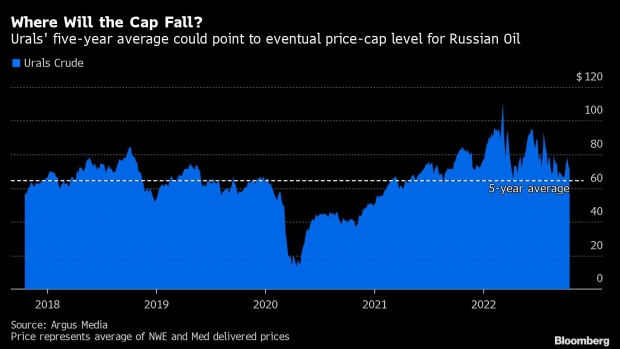Oct 21, 2022
US Eyes Russia Oil Price Cap Above $60 to Keep Supply Flowing
, Bloomberg News

(Bloomberg) -- US officials may aim to set a price cap for Russian oil exports above $60 a barrel, a higher level than earlier signaled.
That’s based on speeches and references to historical pricing data that officials have said they will use as a partial guide. Earlier discussions on the plan, devised by the US Treasury Department as part of the broader international reaction to President Vladimir Putin’s invasion of Ukraine, focused on a ceiling in the $40 to $60 range.
The US has sought a price that would be high enough to cover production costs and encourage continued output. Meanwhile, Putin and other Russian officials have said that they won’t sell to countries that are backing the cap, which has been criticized by industry insiders and even some US allies as unworkable.
A higher cap would cut against one of the publicly stated goals of the plan, which is to deprive Moscow of oil revenues that help finance the war. Yet it would also align with the cap’s other goal -- keeping Russian oil on the market -- as US midterm elections near and gasoline prices creep up.
“The last thing you want is to make Putin shut in production and facilitate a large disruption of Russian crude,” said Hunter Kornfeind, an oil market analyst at Rapidan Energy Group, adding that the cap will likely be close to what Russia’s benchmark Urals crude is trading at now.
The US position is coming into focus as officials from nations participating in the plan meet this month to determine the cap levels, for both crude and some refined products.
Treasury Secretary Janet Yellen and her deputy, Wally Adeyemo, have repeatedly pointed to historical prices for Russian oil as a guide in setting the cap. The average delivery price for Urals crude, a major Russian export, was $63 a barrel for the past three years and $64 over five years, according data from price reporting agency Argus Media. It has averaged almost $74 this month.
“The price will be set jointly with our coalition and no decision has been made,” Treasury spokesman Michael Gwin said this week in response to a question on where historical pricing may point the eventual price cap. “The level Russia has historically sold oil at is just one data point we are considering.”
The price-cap is designed as essentially an escape valve for oil blocked up by EU and UK sanctions, which will ban companies in those jurisdictions from shipping, financing or insuring cargoes of Russian oil anywhere in the world, starting Dec. 5.
The US fears those restrictions would trap oil inside Russia and cause global prices to spike, so the Treasury has pursued a plan to allow shippers access to those services if their cargo is priced at or below a cap.
So far, governments from the Group of Seven leading economies and the EU have endorsed the idea in principle. Many details remain unresolved, including how the cap fits into the EU’s evolving sanctions against Russia.
Marginal Cost
Yellen and Adeyemo have outlined the main factors they believe should go into setting the cap. As a starting point, Adeyemo said the price should be above Russia’s “marginal cost of production,” allowing even the least efficient Russian wells to make some profit.
To ensure profitability for producers, the cap may also have to build in logistical and delivery costs typically borne by the seller, according to Raoul LeBlanc, an analyst at S&P Global Commodity Insights, who added that price history suggests the delivered cost for Russia’s marginal producers is somewhere around $50 a barrel.
Treasury officials have slightly shifted their language over time about where they wish to draw a floor under the prospective cap price. Early on, officials suggested setting the price “slightly above” cost. More recently, Adeyemo said in a television interview the US wanted it “well above the price of production.”
The price for Russia’s Urals crude has averaged just above $81 a barrel this year, compared with $69 in 2021, according to Argus data, which reflects prices for cargoes delivered to European oil refining centers around Augusta, Italy, and Rotterdam, in the Netherlands.
The Treasury has looked to historical prices as a guide to dilute any recent price spikes caused by the invasion, which raised supply fears, and would also help determine a price Russia has accepted in the past.
“Given that the point of the whole thing is to induce the barrels to flow on to the global market, the higher the cap price, the better chance they have,” said S&P’s LeBlanc.
--With assistance from Alaric Nightingale.
©2022 Bloomberg L.P.





